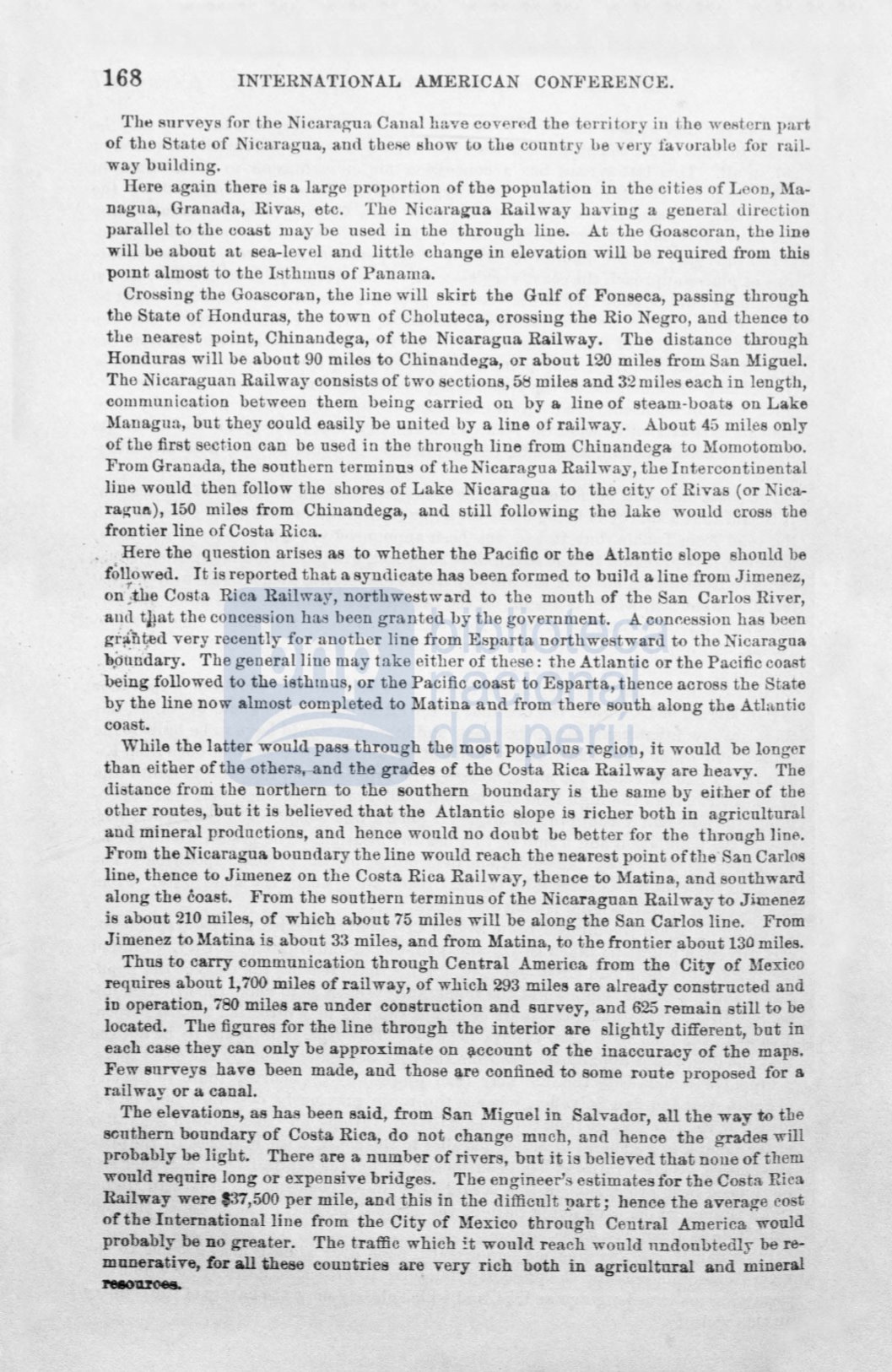

168
INTERNATIONAL AMERICAN CONFERENCE.
Th~
snrveys for the Nicaragua Canal
h~~ve cov~>rP,d
tbe t err itory iu t be westeru part
of the State of
Ni
amgua, and tbe e show to the country be very favorable for rail–
wa.y building.
Here ag:J.i.n there is a large proportion of tbe population in the cities of L on, Ma–
nngna., Granada, Rivas, etc.
The Nicaragua Ra.ilway having a general uirection
parallel to tbe
coa.stmay be used in the through line.
.At the Goascoran, the line
will be about at sea.-level and little cbange in elevation
will
be required from this
pomt alrnost to the I:sthmus of Panama.
Cro ·sing tbe Goa ·coran, the line will skirt the Gulf of Fonseca, passing through
the State of Honduras, the town of Choluteca, crossing the Rio Negro, and tbence to
the nearest point, Chinandega, of the Nicaragua Railway. The distance through
Honduras will be about
90
miles to Chinandega, or about
120
miles from San Miguel.
Tbe Nicaraguao Ra.ilwa.y consists of two sections,
58
miles
a.nd32
miles eacb in length,
comruunication between them being ca.rried on by a line of steam-boats on Lake
Managua, but they could easily be united by a line of railway. About
45
miles only
of the first sect.ion can be used in tbe tbrongh line from Chinandega to Momotombo.
From Granada, the southern terminus of the Nicaragua Railway, the Intercontinental
line would then follow the sbores of Lake Nicaragua to the city of Rivas (or Nica–
ragua),
150
miles from Chinandega, and still following the lake wonld cross tbe
frontier line ofCosta Rica.
Here the question arises as to whether the Pacific or the Atla.ntic slope should be
followed.
It
is reportad that a syndicate has been formad to build a line from Jimenez,
on~the
Co t.a. Rica Railway,
northwestwo.rdto the mouth of the San Carlos River,
aml tJ:}at tbe conces ion ha been granted by the government. A conC\ession has been
gr¡{ñt¡ed very recently for a.notber line from Esparta northwestward to the Nicaragua
h~~ndary.
The generalline
m
ay take eitber of these: the .Atlantic or the Pacific coa t
being followed to the isthmus, or the Pacific coast to Esparta, thence across the State
by the line now a.lmost completad to Matiua. and from there sonth along the Atlantic
coa
t.
While the latter would pass through the most popnlous region, it wonld be longer
than either oftbe others and the grades of the Costa Rica Railway are heavy. The
di tance from the northern to the sonthern boundary is tbe same by eit.her of the
other routes, but it is believed tbat the Atla.ntic slope is richer both in agricultura!
and mineral produetion , and hence would no doubt be better for tbe through line.
From the Nicaragua boundary the line wonld reach the nea.rest point ofthe San Carlos
line, thence to Jimenez on the Costa Rica Railway, thence to Matina, and southward
along the éoast. From the southern terminns of the Nicaraguan Railway
to
Jimenez
is abont
210
miles, of which about 75 miles will be along the San Carlos line. From
Jimenez
to
Matina
is
about 33 mile , and from Matina, to the frontier about 130 miles.
Thns to carry commnnication through Central .America from the
City
of Mexico
requires abont 1,700 miles ofrailway, ofwhich 293 miles are already constrncted and
in operation, 780 miles are under construction and survey, and 625 remain still to be
located. Tbe figures for tbe line through the interior are slightly different, bnt in
each case they can only be appro:rimate on
~ccount
of the inaccnracy of the
ma.ps.
Few snrveys have been made, and those are confinad to sorne ronte proposed for a
mil way or a canal.
Tbe elevation , as ha been said, from San Miguel in Salvador, all the way
to
tbe
seuthern bonndary of Costa Rica, do not change much, and hence the grades will
probably
be
light. There are a nnmber of river , bnt it is believed that noue of them
would require long or expensive bridges. Tbe engineer' e timates for the Costa Rica
Railway were
$37,500
per mile, and this in the difficult part; hence the average co ·t
oftbe Internationalline from the City of Mexico through Central .America wonld
probably be no greater. The traffic which !t would reach would nndoubtedly be re–
munerativa, for
all
tbese countries are -very rich botb in agricnltnral and mineral
.reeonoee.
















